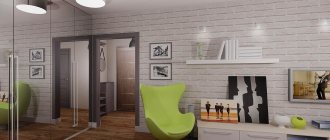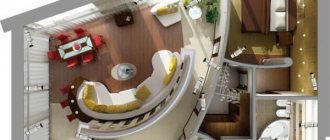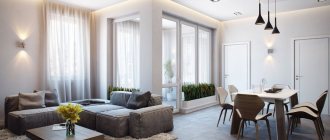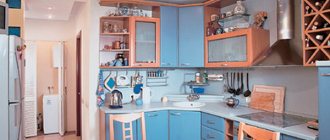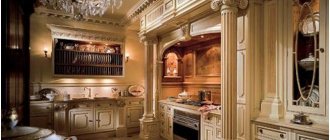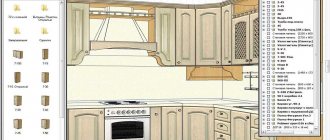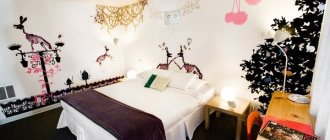A typical Japanese apartment with an area of 8 square meters is striking in its ergonomics
Some people need very little to be happy. A young girl from Australia can confidently confirm this. Recently, Emma, who loves to travel the world, decided to settle in Japan. She rented a tiny apartment with a total area of 8 square meters in the very center of Tokyo. It’s impossible to believe it, but a kitchen, a bathroom, a sleeping area and even a small balcony fit into the microscopic space.
It is known throughout the world that Japan has too high a population density. The Japanese are forced to make do with cramped rooms and in most cases have no privacy. But even by local standards, this apartment is too small. By stretching her arms out to the sides, Emma can easily touch the opposite walls of her home. Luckily, some thoughtful design elements can help a miniature apartment remain functional and very cozy.
High ceilings add some free space. Large windows let in plenty of daylight. And if you go out onto a tiny balcony, you can feel the rapid movement on the streets of a big city.
People who are used to cooking a lot and deliciously will find it difficult in this kitchen. There's a sink and a small stove, but absolutely no room to spread out. You can cover the sink with a cutting board and cut vegetables this way. But Emma admits that in these conditions only the simplest dishes can be prepared.
The kitchen space seems catastrophically small, although this is quite a common situation in Japan. Many Tokyo apartments have kitchens of the same size. The fact is that working people usually eat outside the home or bring ready-made food with them.
The bathroom was designed by a brilliant designer. In fact, it is a shower stall in which the toilet is installed. At the same time, the washbasin moves easily and can completely cover the earthenware product. Then there is additional space in the bathroom, quite sufficient to take a shower comfortably.
The bed is located on the second floor, just above the entrance to the apartment. You can get there via a small staircase. You can really feel claustrophobic here. But this doesn’t scare Emma at all. On the contrary, she compares a cramped bedroom with a cozy hole or cave and feels protected and calm while sleeping.
The girl claims that she fell in love with the tiny apartment, which costs about $600 a month. She is grateful for a small space where she can hide from prying eyes and take a break after a hectic day.
Emma spent her childhood and teenage years in Australia, where the pace of life is more measured. In the huge and crazy Tokyo, a person desperately needs a break. And she is very glad that she can enjoy a short pause, a moment of peace and tranquility in her miniature home.
Economic issues
Heating
Local rather than centralized heating is the norm in Japanese homes. Homes are typically rented and sold without heating or cooling equipment—families bring them with them when they move.
The simplest kerosene heater has a fuel tank, a protective casing and a control panel. Electric ignition from batteries has recently become increasingly popular. On the next level there is an electric fan that circulates hot air around the room. Many of these fans are equipped with a function for independent control of the temperature in the room, and can also be turned off or on according to a given mode.
Gas heaters are also popular and many homes are heated with gas through individual portable heaters. The windows in many homes have an air vent to protect occupants from excessive exhaust fumes.
Kerosene or gas heaters, when shaken, cut off the fuel supply and stop working, which is very useful in case of accidents or earthquakes. These devices also automatically turn off after two or three hours of operation to prevent the air in the room from becoming overly saturated with carbon monoxide while, for example, the owner of the apartment is sleeping.
Another type of kerosene heater functions like a radiator and consists of two parts. The tank with kerosene is located outside the house and the fuel is also burned outside the house, heating the liquid, which spreads through the second part of the heater, directly heating the room. This type of heating is very popular because it significantly reduces gas pollution and smoke in the room and virtually eliminates the possibility of injury to children or animals who accidentally damage the device.
Electric heaters in Japan are usually mounted above the door on a veranda or balcony and often do work adjacent to the air conditioner. Most of them are equipped with a timer and temperature control function.
In northern Japan, yukadanbō (床暖房; "floor heater") radiant heaters , which are located below floor level, are common and are now installed in some apartments and rooms of newer buildings that use heated fluid for heating. The cost of such a device is quite high and often it is installed only in a small room where people change clothes. Electric carpets and flooring have become popular in recent years.
And finally, do not forget about the traditional heating method - kotatsu - which is still widely used today. This is how rooms in the traditional Japanese style, which are now installed in modern homes, are usually heated.
Electricity
Japanese homes are connected to the national electrical grid, which operates at 100 V. The frequency of alternating current in eastern Japan is 50 Hz, in western Japan it is 60 Hz. Typical current is 30 or 50 A. Many appliances operate properly at any frequency.
The sockets are for the most part similar to those used in the US, with two vertical slots, but unlike modern American sockets, the slots in Japanese sockets are usually made the same width and there is no third slot for grounding. Devices that come into contact with water, such as heated toilets, often have their own separate ground wire.
Lighting equipment, like heaters, usually falls on the shoulders of the immediate residents. Many homes do not have light fixtures in the bedroom, living room or dining room. Instead, they only have a socket where you need to connect the required device. Kitchens, bathrooms, hallways and genkan usually have lights built into the ceiling.
Safety
An interphone or intercom is standard equipment in Japanese homes. There are models with video cameras, but as a rule, a peephole is enough for most houses and apartments. In Japan, there is a custom whereby the guest waits for the host at the gate of the house, so intercoms are usually installed there, and not directly in front of the door. Nowadays, it is very common to use an electric gate lock that can be controlled from the comfort of your home, and interphones with cameras are becoming more common.
Building a house
Many single-family homes are built by (now finally renamed Panasonic), Misawa Home, Mitsui and Sumitomo Forestry. Some such companies show portfolios to potential buyers and open showrooms to showcase their products.
Construction Materials
Wooden frames are very popular for detached houses. The two-by-four design is an alternative to the traditional Japanese style. Houses can be sheathed in some material or covered with ceramic tiles, which can be of various colors and covered with glaze.
Walls are often erected without using mortar, i.e. using the dry masonry method and covered with paint or wallpaper. A common roof covering option is shingles, which are made from clay or concrete.
Large buildings are usually built from reinforced concrete, and their roofs are filled with bitumen or covered with synthetic materials.
Rules for building a home
Typically, the allowed maximum for wooden houses in Japan is two stories. Some of these houses may have an attic, but it is used only for storage space; no one has bedrooms there - unlike our village houses.
Buildings made of reinforced concrete can have a larger number of floors, but as a rule, they are also limited to two. Foundations for private houses are rare, but absolutely required when constructing high-rise buildings.
The ratio of the building area, including the area of the house itself and the plot of land on which it is built, is regulated in accordance with a system called kenpeiritsu (建ペイ率) . For example, in some areas the built-up area may only be 80% of the total land area. Depending on the location, kenpeiritsu may vary.
The taxable value of the house also includes the building material from which the house was built. Timber houses are considered to have a lifespan of 20 years, but in some cases the lifespan can be as long as 30 years. Their assessed value, accordingly, decreases every year - in contrast to the housing market in other countries. Most real estate agents use this pricing policy as a guideline.
